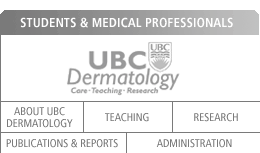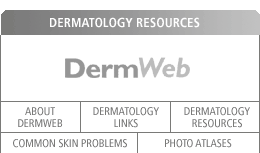|
|
 |
 |
 |
Hair Disorders
The primary goals for the medical treatment of Hair Disorders are to treat the underlying cause, re-grow the hair when possible, and correct damaging grooming practices.
Hair Disorders comprise four main categories of problems:
Alopecia
This is the loss or thinning of hair, of which there are two categories.
Non-scarring Alopecia can be reversible, and involves:
- hair loss all over or in circular areas
- receding hair line
- broken hairs
- smooth scalp
- inflammation
- possibly loss of lashes, eyebrows, or pubic hair.
Non scarring Alopecia is the result of one or more of the following:
- skin disorders
- certain drugs
- certain diseases
- autoimmunity
- iron deficiency
- severe stress
- scalp radiation
- pregnancy
- pulling at your own hair
Scarring Alopecia is due to the hair follicles being destroyed:
- it is usually limited to particular areas
- there is generally inflammation at the edge of the affected area with no hair in the centre of the lesion this is due to loss of the follicle
- the skin can look a violet-color
- scaling may be present
Scarring Alopecia is the result of:
- various skin disorders
- some diseases
- or a bacterial infections
People who are most at risk of developing Alopecia are male, people with a genetic predisposition, being pregnant, under physical or emotional stress, and having a poor diet.
Treatment can include:
- Minoxidil to promote hair regrowth and prevent further loss,
- Tretinoin to decrease the thickness of the scalp
- topical or injectable steroids
Male-pattern baldness (androgenic alopecia)
This is the most common type of hair disorder, which affects half of all men over 50 years old in varying degrees.
It is a type of hair loss that occurs slowly over years, and can start anytime after the age twenty. There is usually a family history of hair loss. In women, the hair slowly becomes thin throughout the scalp and bald spots usually do not occur. Men most commonly develop hair loss first at the temples, followed by an enlarging bald spot on top of the head.
There are identified patterns describing how the hair thins, and each pattern has stages of progression, from initial loss to partial or full baldness.
Androgenic alopecia is due to how the hair responds to hormones. This is due to genetic factors and is not caused by foods or the result of nervousness.
Various medications can be used to slow the hair loss, and in some patients to reverse the hair loss.
The most effective method of dealing with the problem of male pattern baldness is hair transplant surgery and which relocate hair from the back of the head which is usually not hormone-sensitive to the areas where hair loss has occurred.. The transplanted hair retains its resistance to the hormone’s effects and grows as it would have before being relocated.
Hirsutism
This affects approximately 8% of adult women who develop a male pattern of hair growth. It is often accompanied by the following:
- irregular menstruation
- lack of ovulation
- acne
- deepening of the voice
- balding
- genital abnormalities
Hirsutism is caused by an excess of androgen. Androgen is the steroid hormone that stimulates development of the male sex organs and secondary sexual characteristics. This overproduction of androgen can result from certain drugs or conditions, from a genetic predisposition to override the hormone, or to a lack of ovulation.
Treatments included the use of steroids, oral contraceptives, and possibly even the removal of an ovarian tumor.
Hair shaft disorders
These are usually hereditary abnormalities in the hair shaft which result in:
- split ends
- dry hair
- brittle hair
- coarse hair
- other abnormalities of the skin and body may occur in conjunction with the above
This is often caused by one or more the following:
- excessive colouring of hair
- excessive application of permanent waves to the hair
- excessive heating
- certain diseases
- genetic predisposition
Treatment may be Minoxidil for the hair or other medications to treat the underlying diseases.
« Back to Common Skin Disorders
modified 012508 |
|
 |
|

